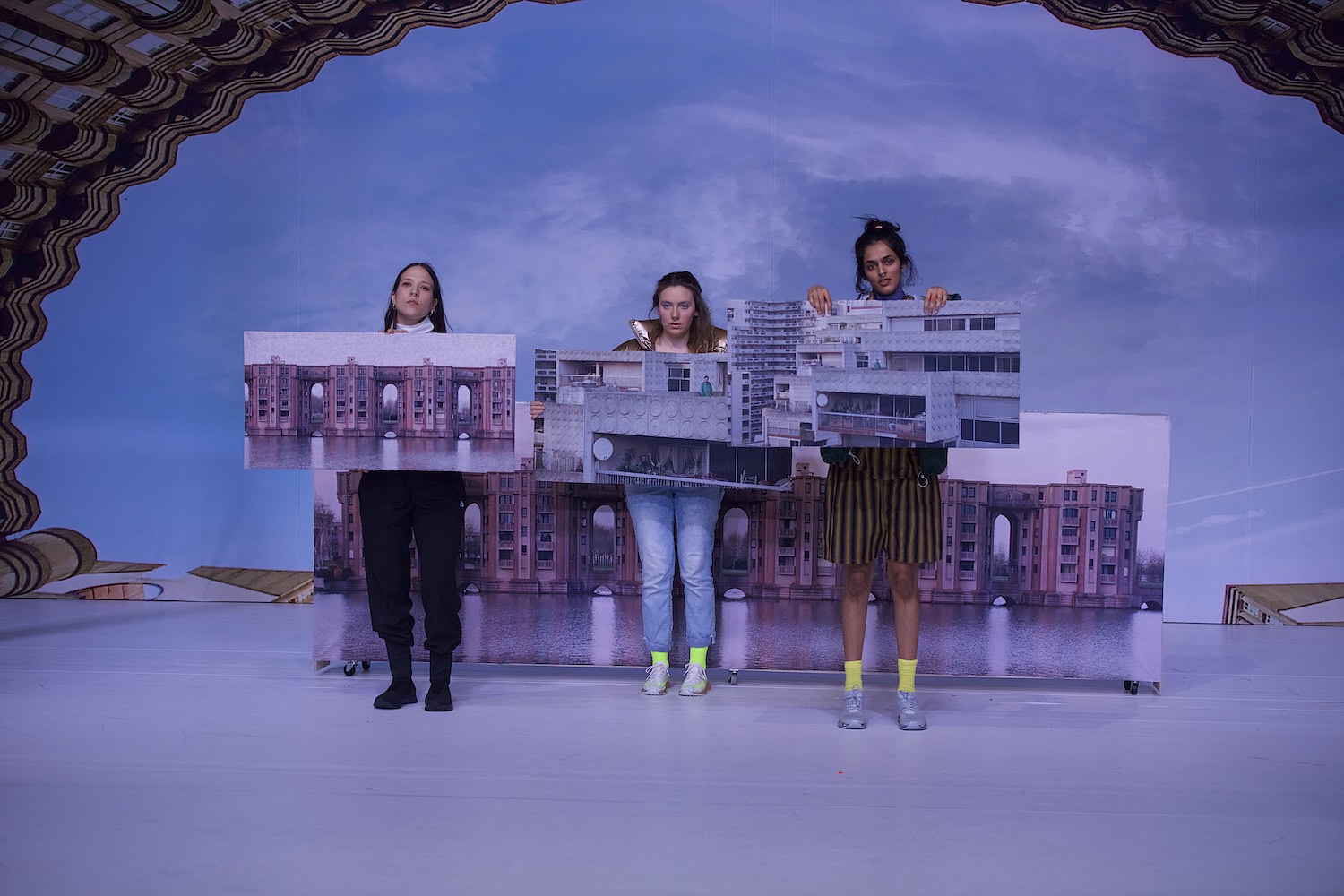
THE END OF THE ROAD
![]()
A group of teenage girls meet. Sitting on a bench, they share memories and songs, discuss their personal and collective troubles, and dream of what they could become, oscillating between boredom and panic in the highly-planned architecture of their environment. Trapped amongst the remains of an urban nightmare built on earnest but misguided community housing projects, they wonder: Are there still possibilities waiting at The End of the Road?
In this work, Cécile Bally uses Sitcom-strategies to examine “Teenage Angst” and visions of radical change at the peripheries of urban life. A maximalist scenography made of moving backdrops and an orginal soundtrack by the rapper Haszcara transport the audience into an imaginary space at the borders of the city. The End of the Road is a celebration of «zoner», a french verb describing the action of «hanging out outside while doing nothing» : a verb used to criticize a lifestyle associated with young people living in the French suburbs, «zoner» is here presented as a space of potentiality outside of consumerism, based on friendship and use of public space.
DE
Dystopische Vororte, Teenager*innen, ihre Träume und Albträume: Eine Performance - Sitcom.
Eine Gruppe Teenagerinnen trifft sich. Sie träumen von der Zukunft und teilen sowohl individuelle als auch kollektive Erinnerungen, schwanken zwischen Langeweile und Panik in der hochgeplanten Architektur ihrer Umgebung. Gefangen in den Überresten eines urbanen Albtraums, der auf fehlgeleiteten Gemeinschaftswohnprojekten aufgebaut ist, fragen Sie sich: Was erwartet Sie am Ende der Straße? Cécile Bally nutzt das Sitcom-Format, um „Teenage Angst“ und Visionen radikaler Veränderung in der Peripherie des Stadtlebens zu untersuchen. Sie führt das Publikum in einen imaginären Raum hinter den Grenzen der Stadt.
CONCEPT, CHOREOGRAPHY Cécile Bally PERFORMANCE Julia Plawgo, Sunayana Shetty, Layton Lachman, Cécile Bally RAP - ORIGINAL SOUNDTRACK Haszcara DRAMATURGICAL SUPPORT Alexandre Viard, Jonas Rutgeerts LIGHT DESIGN Emma Juliard SOUND DESIGN Jassem Hindi STAGE DESIGN Pablo Ramón Benitez, Cécile Bally COSTUMES&PROPS Sara Wendt OUTSIDE-EYE Asaf Aharonson PRODUCTION Ann-Christin Görtz, Valerie Terwei PRESSE Louise Trueheart
A production by Cécile Bally in co-production with SOPHIENSÆLE. Funded by the Capital Cultural Fund. With the support of De School van Gaasbeek and Flutgraben Performances.
↦ TRAILER
Premiere / 13. - 16.02.2020 Sophiensaele, Berlin





Different buildings from different peripheries perform as the background for this piece:
LES ÉSPACES D’ABRAXAS (1982), built by Spanish architecht Ricardo Bofill, is the kind of post-modern utopian housing project erected to solve a housing crisis in the east of Paris. It hosts 600 living units, spread out over three buildings. Inspired by the Greek Odeon and the Roman Amphitheater, this place was designed to be centered around itself in an attempt to decentralize the Parisian metropolis. Its purpose failed. Due to its futuristic atmosphere the building has been the scene for dystopian science ction lms, such as Brazil (1984) and The Hunger Games: Mockingjay (2015).
WBS 70 OR WOHNUNGSBAUSERIE 70, is a specic type of Plattenbau, a construction method that makes use of large prefabricated concrete slabs. The technique enabled the German Democaric Republic (GDR) to develop whole new areas very fast. Throughout the 1970s, WBS 70 buildings rose up all over Berlin. One of the prime examples – ‘die Platte aller Platten’ – can be found on Roederplatz. In the same place, there is a series of another type of Plattenbau (WBS/QP 71-R) adorned by big rainbows.
LES DAMIERS (1976), built by Jacques Binoux and Michel Folliasson in Courbevoie, a suburb of Paris that became a major business district over the last years. It comprises 640 apartments divided in four buildings. Twelve years ago, the inhabitants of Les Damiers learned that the buildings would be demolished and replaced by two gigantic towers, the Hermitage Plaza, which should host of ces, high end appartments and a Hotel. The habitants of Les Damiers have been evicted but due to a lack of funding, the construction of the towers hasn’t started yet.
LES ARCADES DU LAC (1981), built by Ricardo Bofill, is an ensemble of appartement buildings located 25km west of Paris. Due to its close proximity to Versailles, but also due to the immensity of the building, the Arcades are also known as the “Versailles of the people”. Constructed as a pedestrian area, the site is suprisingly empty as all blocks are connected through an underground parking system which makes it uncessary to pass through the outside to go home.


Photo credits on stage : Mikhail Vassiliev, Inese Kalnina, Laurent Kronental, Pierre Châtel-Innocenti, Cécile Bally
